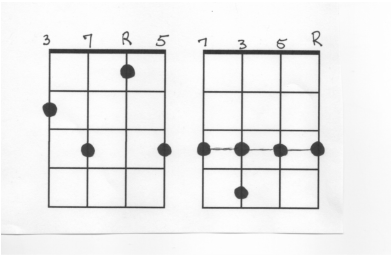We focused on harmonizing on the Ukulele and some 12 bar blues riffs using closed chord shapes.
Continue practicing the harmonized scales and aim toward getting away from the paper. As always, it is the goal that your fingers eventually will know where to go to find those harmonies. Use Morning Has Broken (below) as an exercise to try to figure out the harmonies for the simple melody.
We then concentrated on two closed chord shapes to play the 12 bar blues. The shapes below (as shown) for playing in the keys of C and G (or any key, depending on which fret you are on. The R indicates the Root, which tells you what the chord is.
Just have some fun playing the 12 bar blues with the list or make up your own 12 bar blues tune. There will be a gold star for everyone who comes to class with their own 12 bar blues song next week!
In Book 3 Practice Kabak da Boynuma. A sweet, little simple song from Azerbaijan.
Continue practicing the harmonized scales and aim toward getting away from the paper. As always, it is the goal that your fingers eventually will know where to go to find those harmonies. Use Morning Has Broken (below) as an exercise to try to figure out the harmonies for the simple melody.
We then concentrated on two closed chord shapes to play the 12 bar blues. The shapes below (as shown) for playing in the keys of C and G (or any key, depending on which fret you are on. The R indicates the Root, which tells you what the chord is.
Just have some fun playing the 12 bar blues with the list or make up your own 12 bar blues tune. There will be a gold star for everyone who comes to class with their own 12 bar blues song next week!
In Book 3 Practice Kabak da Boynuma. A sweet, little simple song from Azerbaijan.
| morning_has_broken.pdf |
| 12_bar_blues_box_chart-7th_chords.doc |

 RSS Feed
RSS Feed